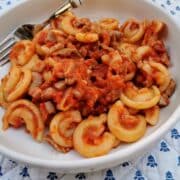Prosciutto Ragu with Dischi Volanti Recipe from Emilia-Romagna.
This prosciutto ragu with dischi volanti pasta is a fabulous alternative to Bolognese. It’s faster and easier to make but just as flavourful! With just 3 main ingredients, this is perfect for weeknights.
Servings: 4
Calories: 838kcal
Ingredients
- 400 g dischi volanti pasta (14oz) also called messicani or other short pasta
- 300 g prosciutto crudo (10-11oz) diced
- 2 shallots peeled and finely chopped
- 20 g butter (1oz)
- ⅓ cup milk
- 400 g tomato passata (14oz) or polpa (which is thicker)
- salt for pasta
- Freshly ground black pepper. to taste
- 60 g Parmigiano Reggiano (2oz) to serve
Instructions
- Cut the prosciutto into small pieces (without removing the fat) Peel and chop the shallots.
- Saute the shallots in a heavy frying pan or skillet in the butter. After a minute add half the prosciutto pieces.
- Cook over a medium heat for about 3-4 minutes,stirring frequently to prevent the ham from burning or sticking.
- Then add the tomato passata and continue cooking on a low heat for about 15 minutes. Every now and then add a little milk until you’ve used it up. Add the rest of the ham and cook for another 5 minutes. Add black pepper as required.
- While the sauce is simmering put a pot of water on to boil for the pasta. Add salt once it starts to boil and bring to the boil again. Cook the pasta al dente according to the instructions on the packet. When the pasta is ready, save a cup of the cooking water and drain.
- Add the pasta to the sauce and mix well. If the sauce seems dry add a little of the pasta cooking water. Serve immediately with grated Parmigiano Reggiano.
Notes
I served this prosciutto ragu with dischi volanti pasta. Traditionally it's eaten with tagliatelle but other pasta is good too.
The prosciutto is added to the sauce in two stages so some is well cooked and some still a little fresh. This helps to emphasize the prosciutto flavour!
Nutrition
Calories: 838kcal | Carbohydrates: 88g | Protein: 31g | Fat: 40g | Saturated Fat: 16g | Polyunsaturated Fat: 6g | Monounsaturated Fat: 16g | Trans Fat: 0.3g | Cholesterol: 73mg | Sodium: 812mg | Potassium: 898mg | Fiber: 6g | Sugar: 10g | Vitamin A: 813IU | Vitamin C: 12mg | Calcium: 251mg | Iron: 4mg
